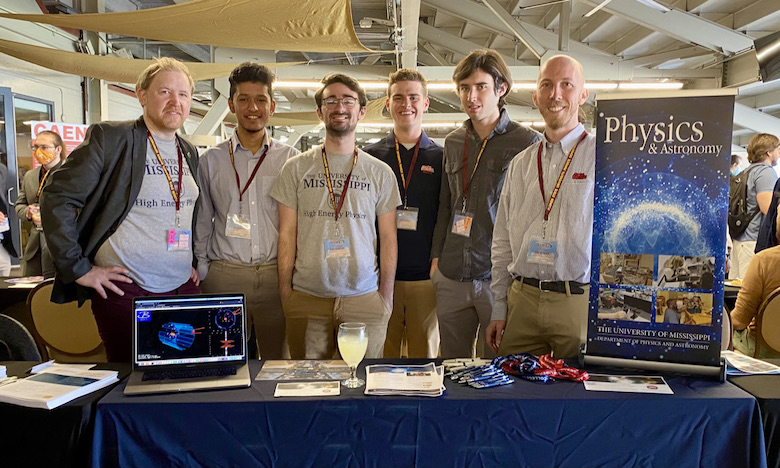
The University of Mississippi table at the 88th conference of the American Physical Society Southeastern Section at Florida State University in Tallahassee in November 2021 are pictured from left to right: Gavin Davies, assistant professor working on experimental particle physics with the NOvA experiment; Sakul Mahat; Paul Gebeline; Wil Stacy; Matthew Mestayer; and Jake Bennett, assistant professor working on experimental particle physics with the Belle II experiment.
Wil Stacy is a senior from Southaven, Mississippi, majoring in physics at the University of Mississippi.
He is working with Jake Bennett, an experimental elementary particle physicist and assistant professor in the Department of Physics and Astronomy, and presented his research findings as part of the Belle II experiment at the annual meeting of the Southeastern Section of the American Physical Society at Florida State University in Tallahassee in November 2021.
The Belle II experiment at the SuperKEKB accelerator in Japan—a collaboration with more than 1,000 physicists and engineers from 26 countries—aims to investigate great mysteries of particle physics, including why, if matter and antimatter should have been created in equal amounts after the big bang, is the universe today filled almost entirely with matter?
At the conference, Stacy completed a study characterizing the performance of the Belle II detector to identify charged particles. The response of different detectors hints at type of charged particles that are created in the electron-positron collision. Those detector responses must be carefully calibrated and understood before precision measurements of interesting particle decays can be made.
“My goal was to measure the efficiency (what percentage of the time do we get it right) of the detectors to properly identify protons,” Stacy said. “This information was relayed to detector experts, to help them improve their software, and is made available to analysts so they can better understand how to get the most accurate data possible.”
How did your interest in physics develop?
I was first introduced to physics back in middle school when I saw an article about the discovery of the Higgs Boson. I didn’t know what that meant, but the words “speed of light” and “collision” piqued my interest, so I looked up many of the terms in the article, trying to understand high energy physics before I even knew algebra; predictably, it went way over my head and frustrated me like I had never been before. From that point on, I knew that I wanted to become a physicist.
Talk about your college experience as a physics major and work participating in research.
Being a physics major has its pros and cons like any other major. I may have a caffeine dependency now, but the opportunities I’ve had and the concepts I’ve been taught have more than made up for it. This conference is actually a perfect example: not every school offers you the chance to share the results of your work with your peers. I honestly didn’t think I was ready to do so, but through Dr. Bennett’s encouragement and guidance, as well as some practice runs, I was able to put together a presentation within a few weeks and present it successfully. My favorite part of doing research here is the fact that I was immediately able to work in the field I’m interested in, high energy physics.
Discuss your career goals.
I have two goals that I hope to achieve in parallel: My first goal is to make many contributions to the field of high energy physics through my future research. My other goal is to attain my PhD and eventually earn a teaching position at a university. I’ve always enjoyed teaching, and the UM Physics department has given me many opportunities to do just that even as an undergrad.